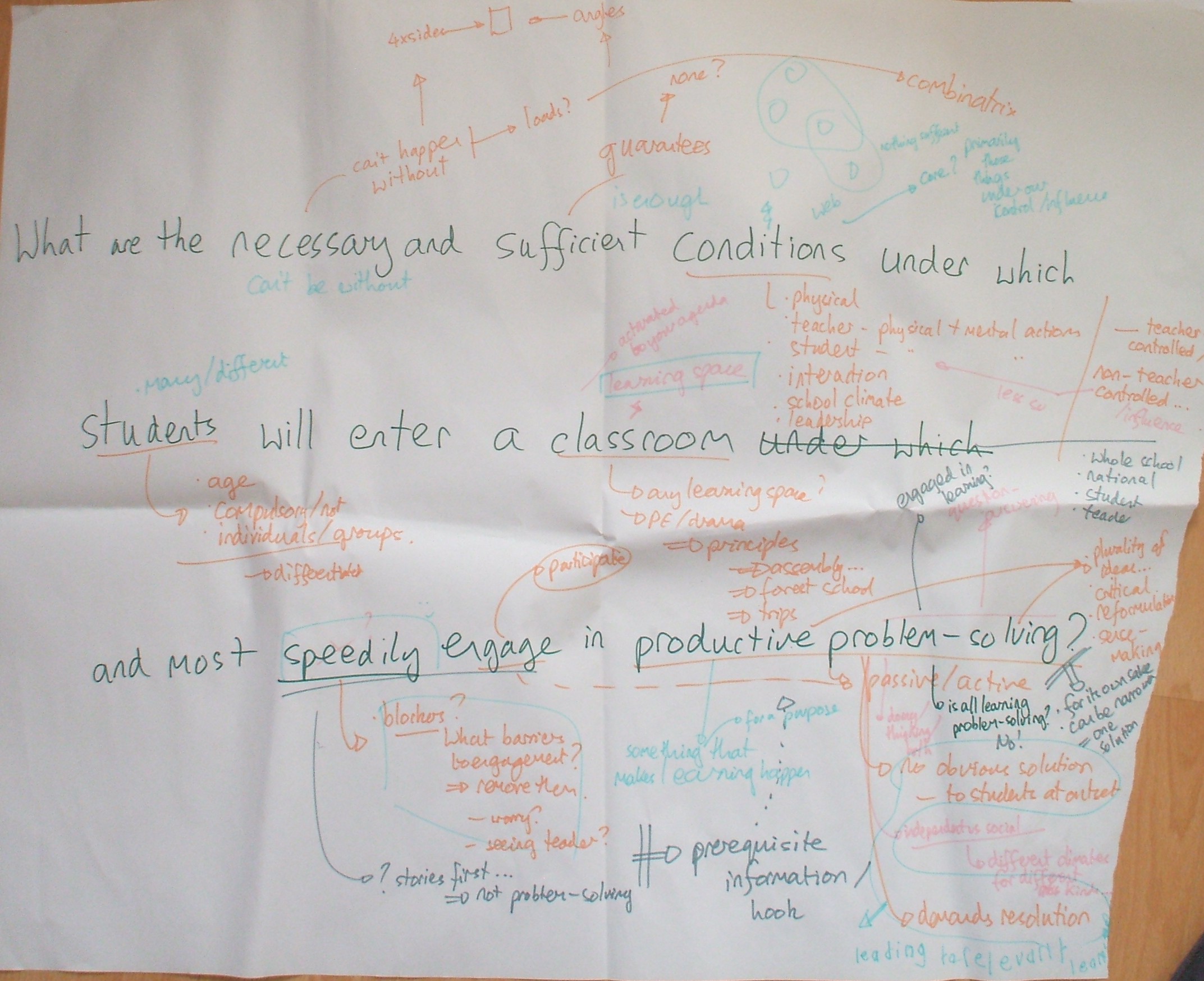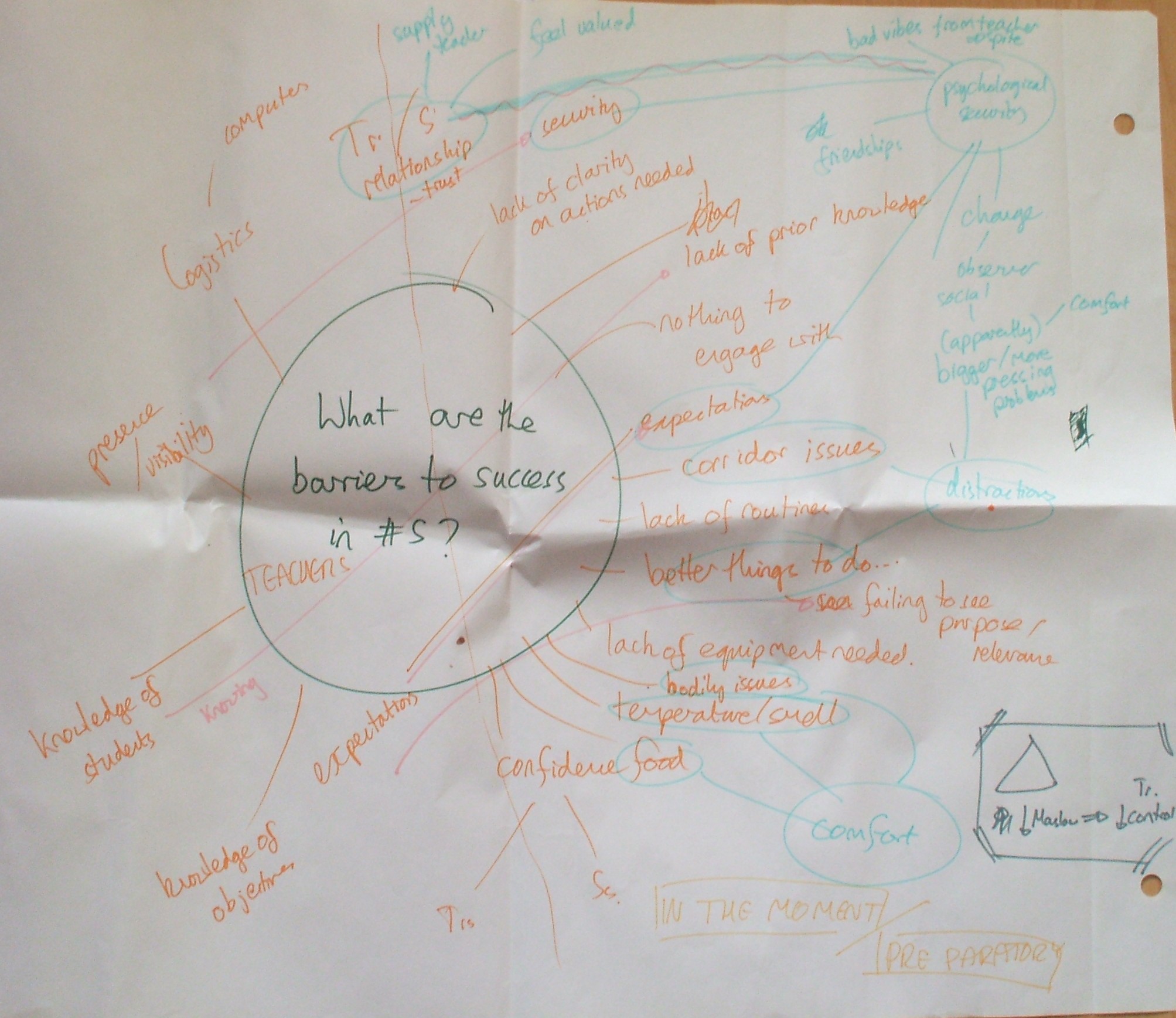There is a certain logic to many of the titles our group toyed with for our findings: ‘The Golden Five Minutes’ expresses the importance of the beginning of the lesson; ‘The Taming of Year Two,’ sounds great, although we have tried to make our solutions universally applicable; ‘The three-sixty 360’ covers the number of strategies we would like to have available to meet our eight conditions for success. Hiding in cupboards is a research method, unveiled later in this post – which represents the results of our group’s investigation of Touchpaper Problem Five: What are the necessary and sufficient conditions under which students will enter a classroom and most speedily engage in productive problem-solving?
This post is not ‘mine;’ it records the consensus arrived at by our group: Freddy Cook, Neela Dolezalova, Steve Hoggins and Emma Lark.
The problem: how do we start a lesson well?

In exploring the definition of our terms, we swiftly agreed that we foresaw no sufficient conditions which would guarantee success with all classes. Instead, we believed we were looking for a ‘web’ of necessary conditions, a combination of which, appropriate to a given class and context, would make it possible to achieve our desired intent. We chose to define the initial task of the lesson as productive problem-solving (rather than the main lesson activity) and to focus on conditions within the teacher’s control (so sidelining issues like school leadership and social policy, which are important but which teachers cannot change, at least in the short term).
The barriers: what prevents students engaging immediately in learning?

We synthesised these ideas into eight barriers to student engagement: more pressing problems, physiological needs, teacher-student relationships, motivation in the subject, emotional wellbeing, confidence and fear, logistics and resources and lack of clarity about what to do.
The conditions: what guarantees a good start to a lesson?
Rephrasing these barriers as conditions, as a student might put them, we sought to identify those things without which speedy engagement would not occur, thus (in no order of priority):
1) I understand what I have to do to start tackling the problem.
2) My emotions are managed.
3) My physiological needs are met.
4) I am confident I can engage productively with the problem.
5) I am motivated to try to address the problem.
6) If I have more pressing problems, they are either solved or acknowledged.
7) I have a safe and trusting relationship with my teacher.
8) I have or can get all the equipment I need to engage.
As mentioned above, we believe no single condition is sufficient to guarantee a good start. Many, perhaps most, of these conditions are necessary, but the combination required varies depending on the teacher, class and lesson context. For example, if the condition of a trusting relationship with the teacher is met, other conditions may diminish in importance: students may be more tolerant of uncertainty about the task or less fazed by a lack of confidence. Conversely, a lesson with a difficult class, a new teacher, or an unpropitious time (a rainy Friday afternoon with Year 9) may necessitate more conditions being met: a clearer, more intriguing task which is more obviously attainable. Therefore, for any class, the teacher can identify which of these conditions matter and how they can choose to meet them.
Strategies: how can teachers meet these conditions?
We collected strategies we had employed or knew that fulfilled these conditions. For example, to ensure all students understand how to start tackling a problem, we might wish to:
– Ensure the task is obvious (visible – on the board or on sheets)
– Use recognisable/familiar problem structures
– Clearly communicate expectations
– Provide help sheets
– Have structures or ‘what to do if I’m stuck’ tips visible
– Use clear language to communicate the problem
– Introduce problems bit by bit, checking students have understood each stage
– Ensure students know they can ask if they are unsure
This gallery shows the strategies we came up with (we spent sixty seconds on each condition, so this list is by no means exhaustive):
There is no limit to the strategies available, from which teachers may choose, adapt or innovate, provided their choice fulfils the desired condition.
Studies and steps forward: what about research?
It seems little extant research directly addressing this question (a fairly cursory search of ERIC, for example, turned up fewer than a dozen studies of even tangential relevance) – although there is clearly an extensive literature on conditions such as student motivation or task clarity, which we did not investigate. We discussed how those teachers who have reflected on successful classroom practice, like Doug Lemov, Sue Cowley and Tom Bennett, may offer the most helpful advice on strategies to meet these cupboards.
Hiding in cupboards
We were sceptical of the efficacy of ‘scientific’ trials in this regard, when the variables between lessons (teacher, time, topic, immediate context) are so many. Instead, we discussed using what Laura McInerney had described as our ‘one-person laboratory’ – the classroom – as the site of research. We could, for example, take two weeks in which to cease our actions to meet one condition as a way to see whether this condition is indeed necessary – in Emma’s vivid image, we hide in a cupboard and see how important being able to see the teacher (and student uncertainty) really is.
This might seem ridiculous: obviously students won’t begin learning without a teacher. In the same vein, as I contemplated this idea, I was immediately fearful as to the consequences of removing my treasured entry routines. However, perhaps, through not having tested this, I underestimate my students – there are surely some classes who will begin learning without a visible teacher, if other conditions are met. I realised I cannot describe anything as definitely necessary if I haven’t tried doing without it: I do not know, with certainty, that my entry routines are necessary. Perhaps a time-consuming or labour-intensive action could be removed from the beginning of my lessons without ill-effects; perhaps my students can begin learning more quickly. So, while this approach may contain opportunity costs (a couple of poorly-begun lessons), they may be outweighed by the better understanding we gain in the long run and the benefits derived by other teachers from sharing our findings.
More concrete possible next steps included:
– The creation of an online ‘toolkit’ of strategies which meet out conditions (‘The three-sixty 360’)
– The need to learn more about how other teachers approach these barriers
– The desire to spread our reflections so more teachers are aware of these conditions (this discussion had generated new insights into the way all of us began our classes which may lead us to change our practice – something many other teachers may find likewise)
– The potential to use these conditions as part of an observation schedule and tool for feedback, enabling observers to identify the precise reason why a lesson started well or poorly: ‘the task was clear, but students’ lack of confidence in attempting it combined with the existence of problems they perceived as more pressing hampered the beginning of the lesson’
There are presumably gaps in our conceptualisation – but our time had expired and we felt this provided a useful foundation for future research. Thanks to Freddy, Emma, Steve and Neela for a fantastic day, and to Laura McInerney and Becky Allen for making it happen.
Five groups tackled other Touchpaper Problems; I refer you to Laura McInerney’s synthesis of the day which links to posts written by other groups. Although I found it intellectually intimidating, I recommend in particular the discussion on the complexity of a concept.
For more practical discussion of entry routines, I posted my preliminary ideas on the question here.
I’ve heard tales (I hope apocryphal) of teachers and students locked in cupboards in jest; I hope teachers can now begin to reclaim their cupboards as sites of research.

Reblogged this on The Echo Chamber.
Reblogged this on The TouchPaper Problems.